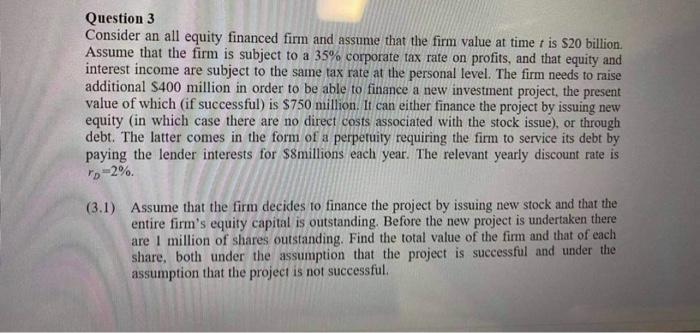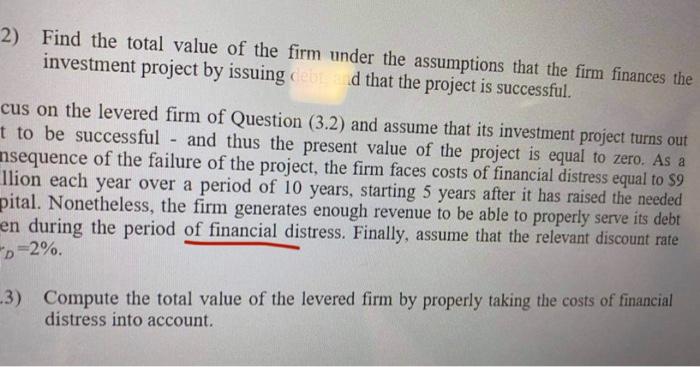Question 3 Consider an all equity financed firm and assume that the firm value at time is $20 billion. Assume that the firm is subject to a 35% corporate tax rate on profits, and that equity and interest income are subject to the same tax rate at the personal level. The firm needs to raise additional S400 million in order to be able to finance a new investment project, the present value of which (if successful) is $750 million. It can either finance the project by issuing new equity (in which case there are no direct costs associated with the stock issue), or through debt. The latter comes in the form of a perpetuity requiring the firm to service its debt by paying the lender interests for $8millions each year. The relevant yearly discount rate is 0-2%. (3.1) Assume that the firm decides to finance the project by issuing new stock and that the entire firm's equity capital is outstanding. Before the new project is undertaken there are 1 million of shares outstanding. Find the total value of the firm and that of each share, both under the assumption that the project is successful and under the assumption that the project is not successful. 2) Find the total value of the firm under the assumptions that the firm finances the investment project by issuing Ed that the project is successful. cus on the levered firm of Question (3.2) and assume that its investment project turns out t to be successful and thus the present value of the project is equal to zero. As a nsequence of the failure of the project, the firm faces costs of financial distress equal to $9 llion each year over a period of 10 years, starting 5 years after it has raised the needed pital. Nonetheless, the firm generates enough revenue to be able to properly serve its debt en during the period of financial distress. Finally, assume that the relevant discount rate p=2%. 3) Compute the total value of the levered firm by properly taking the costs of financial distress into account. Question 3 Consider an all equity financed firm and assume that the firm value at time is $20 billion. Assume that the firm is subject to a 35% corporate tax rate on profits, and that equity and interest income are subject to the same tax rate at the personal level. The firm needs to raise additional S400 million in order to be able to finance a new investment project, the present value of which (if successful) is $750 million. It can either finance the project by issuing new equity (in which case there are no direct costs associated with the stock issue), or through debt. The latter comes in the form of a perpetuity requiring the firm to service its debt by paying the lender interests for $8millions each year. The relevant yearly discount rate is 0-2%. (3.1) Assume that the firm decides to finance the project by issuing new stock and that the entire firm's equity capital is outstanding. Before the new project is undertaken there are 1 million of shares outstanding. Find the total value of the firm and that of each share, both under the assumption that the project is successful and under the assumption that the project is not successful. 2) Find the total value of the firm under the assumptions that the firm finances the investment project by issuing Ed that the project is successful. cus on the levered firm of Question (3.2) and assume that its investment project turns out t to be successful and thus the present value of the project is equal to zero. As a nsequence of the failure of the project, the firm faces costs of financial distress equal to $9 llion each year over a period of 10 years, starting 5 years after it has raised the needed pital. Nonetheless, the firm generates enough revenue to be able to properly serve its debt en during the period of financial distress. Finally, assume that the relevant discount rate p=2%. 3) Compute the total value of the levered firm by properly taking the costs of financial distress into account








